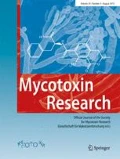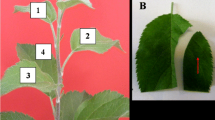Abstract
Main free and bound phenolic acids were determined in ears of wheat cultivars and related to their ratings ofFusarium head blight susceptibility and DON-contents. Ferulic acid concentrations differed strongly during flowering. First results at this step of ear development show that concentrations of ferulic acid were negatively correlated with the relative ratings of cultivars with respect to FHB-susceptibility (r = -0.96) and DON-contents (r = -0.91), which suggests that this phenolic acid plays a role in the defence of fungal attacks by plants.
Similar content being viewed by others
References
Miedaner T (2002) Fusarium head blight in cereals - A growing challenge for farmers and breeders. http://www.uni-hohenheim.de/~ipspwww/720/fusarium.htm
Miedaner T, Reinbrecht C, Lauber U, Schollenberger M, Geiger HH (2001) Effects of genotype and genotype-environment interaction on deoxynivalenol accumulation and resis-tance toFusarium head blight in rye, triticale, and wheat. Plant Breed. 120: 97–105
McKeenan JD, Fulcher G (1997) Wheat phenolic compounds and their role in Fusarium resistance. Polyphénols Actualités 17: 7–10
McKeenan JD, Busch RH, Fulcher RG (1999) Evaluation of wheat(Triticum aestivum L.) phenolic acids during grain developement and their contribution toFusarium resistance. J. Agr. Food Chem. 47: 1476–1482
Régnier T, Macheix J-J (1996) Changes in wall-bound phenolic acids, phenylalanine and tyrosine ammonia-lyases, and peroxidases in developing durum wheat grains(Triticum turgidum L. Var. Durum ). J. Agric.Food Chem. 44: 1727–1730
Reid LM, Mather DE, Arnason JT, Hamilton RI, Bolton AT (1992) Changes in phenolic constituents of maize silk infected withFusarium graminearum. Can. J. Bot. 70: 1697–1702
Anonymous (1998) Beschreibende Sortenliste. Getreide, Mais, Ölfrüchte, Leguminosen, Hackfrüchte. Bundessortenamt, Landbuch Verlag
Wosnitza A (2000) Verbesserung der Fusariumresistenz-Bewertung bei Weizen. In: Fusariumresistenz-Bewertung bei Weizen. Schriftenreihe der Bayerischen Landesanstalt für Bodenkultur und Pflanzenbau 4: 59–74
Pegel H, Nairn M, Rouseff PJL, Zehavi U (1991) Distribution of bound and free phenolic acids in oranges (citrus sinensis) and grapefruits (citrus para-disi). J. Sci. Food Agric. 57: 417–426
Ding H, Lamb RJ, Ames N (2000) Inducible production of phenolic acids in wheat and antibiotic resistance toSitodiplosis mossellana. J. Chem. Ecol. 26: 969–985
Kang Z, Brandi H, Harfold M, Moll G, Buchenauer, H (2000) Ultrastrukturelle Studien zur Infektion vonFusarium culmorum in Weizensorten unterschiedlicher Anfälligkeit gegenüber Ährenfusariosen. Mitt. Biol. Bundesanst. Land-Forstwirtsch. 376: 163–164
Author information
Authors and Affiliations
Rights and permissions
About this article
Cite this article
Engelharclt, G., Koeniger, M. & Preiβ, U. Influence of wheat phenolic Acids onFusarium Head Blight Resistance and Deoxynivalenol Accumulation. Mycotox Res 18 (Suppl 1), 100–103 (2002). https://doi.org/10.1007/BF02946073
Issue Date:
DOI: https://doi.org/10.1007/BF02946073



